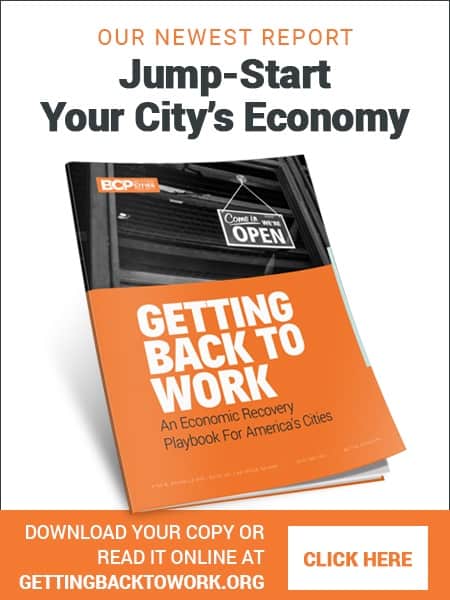Eviction moratoria are set to expire across the country, unemployment is high, and many renter advocates are predicting a “tsunami” of eviction filings.
In a legal eviction, a landlord obtains a court judgment against a tenant who has violated his or her lease, either by causing a nuisance or damage on the property or failing to pay. To reduce exposure to COVID-19 for all involved, many localities suspended eviction procedures in March 2019. The sudden end of moratoria will almost certainly result in a surge in eviction filings, if only owing to pent-up requests. Policymakers can avoid a drastic shock to the rental market by encouraging renegotiation, limiting the pace of evictions, and creating incentives for landlord forbearance.
Tsunami or no?
Surprisingly, data gathered by Princeton University’s Eviction Lab show that the rate of eviction did not increase during the Great Recession, even as the unemployment rate spiked above 10 percent. This suggests that landlords take broad market conditions into account before evicting tenants who miss rent. An otherwise-responsible tenant who pays rent inconsistently is better than an unfillable vacancy.
Rent-payment data from April, May, and June of 2020 show little decline in the rate and timeliness of rent payment relative to 2019. The National Multifamily Housing Council found that 95.1 percent of households in its sample paid rent in May 2020, compared to 96.6 percent in May 2019. Federal Pandemic Unemployment Compensation (FPUC), which provides an extra $600 per week for many unemployed workers, has blunted the impact of job losses. However, FPUC will sunset at the end of July unless Congress extends it.
Although the data warrant qualified optimism, it is always possible for the situation to rapidly deteriorate.
Although the data warrant qualified optimism, it is always possible for the situation to rapidly deteriorate. Localities and states can soften the shock for those who are already affected and prepare for a surge in unpaid rent by pursuing policies that make it easier for landlords and tenants to renegotiate and continue a mutually beneficial relationship.
Encourage renegotiation
States, localities, housing authorities, and apartment associations can expedite and clarify the process of rent renegotiation by providing model renegotiation or forbearance agreements, like the one published by the San Francisco Apartment Association. Model agreements can include such clauses as forgiveness of missed rent, repayment plans, renegotiating the rent rate, and—to benefit landlords—extending the term of the lease. Model text can promote clarity and assure both sides that the agreement will be respected by authorities. Localities should promote a published renegotiation agreement to both landlords and tenants as an implicit endorsement of negotiation.
Limit evictions
In the many jurisdictions that have paused or drastically slowed eviction proceedings, a large backlog of eviction cases is likely to develop whenever new cases are accepted again. In a surge of eviction cases, courts and law enforcement resources are likely to become a bottleneck, placing a burden of wise prioritization on court authorities.
Policymakers should set explicit priority rankings, letting eviction cases involving violence, nuisance, property damage, and other nonpecuniary concerns come to the front of the queue. The Michigan Supreme Court issued such guidance on June 9, 2020. In addition, authorities considering an extension of eviction moratoria should resume evictions at least for cases where tenants pose a nuisance or threat to neighbors. Maryland courts, for example, have resumed landlord-tenant cases “involving threat to person or property” only.
If the eviction rate does surge well beyond its normal rate, policymakers can consider limiting the rate of eviction for each landlord. Giving each landlord an “eviction budget” for the remainder of 2020 (based on number of units and historical eviction rates) will force landlords to prioritize.
Reward forbearance
Local governments can sweeten negotiations between landlords and tenants by releasing property value implicitly held in government hands by restrictive zoning and taxes.
A handful of jurisdictions, including New York City and Montgomery County, Maryland, have active markets in “transferrable development rights” (TDRs). These markets allow property owners to sell the right to develop property. Developers who want to build more densely than their base zoning allows can purchase TDRs from others in the jurisdiction, who thereby give up the right to develop.
In these jurisdictions, policymakers should grant TDRs to landlords who forgive or decrease rent during 2020, in proportion to the dollar value of rent foregone. This implicitly allows tenants to benefit now from development activity that may occur at a later date. Landlords also benefit, forgiving rent that they might never have been able to collect in exchange for TDRs they can hold until the market recovers, selling it to the highest bidder. Future renters also benefit: adding TDRs to the available pool can boost housing production during the next boom and prevent a rapid rise in rent like what occurred during the 2010s economic expansion.
In places without active TDR markets, the cost and difficulty of creating a new TDR market would have to be justified by broader aims. The most successful TDR schemes have been those that create effective political coalitions around clearly defined goals by targeting specific beneficiaries.
Jurisdictions with rent control can also reward landlords by easing future rent ceilings. An $8 per month increase in future rent would be enough, in net present value, to cover $1,500 of rent forgiveness in 2020.
Cities and counties can also reward rent forgiveness and renegotiation by rapidly reassessing rental properties that are assessed on an income basis.
Cities and counties can also reward rent forgiveness and renegotiation by rapidly reassessing rental properties that are assessed on an income basis. Unlike private homes, rental properties are often assessed for property values based on the income they generate. Rent forgiveness causes that income to fall, but the drop in rent received in 2020 may take years to show up in the assessment. By immediately adjusting the income for landlords who verifiably forgive rent and renegotiate, localities would lighten those properties’ relative tax burden.
Conclusion
Evictions are a symptom of larger economic forces well beyond the scope of this brief and ultimately beyond the scope of landlord-tenant law. In the immediate crisis, courts and policymakers must be prepared to handle the pent-up demand to resolve landlord-tenant conflicts. They should choose policies that guide landlords and tenants toward negotiated solutions and prioritize enforcement actions that address dangers and nuisances. Where possible, they should release the value held back by regulation to sweeten negotiations.
As the courts and markets normalize, policymakers should turn to unlocking housing supply to ultimately take the pressure off renters. In a recent policy brief, Emily Hamilton, Nolan Gray, and I outline regulatory reforms that can boost local housing construction and give renters more options at better prices.









